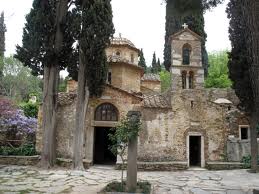
Far from the city and his hubbub, on Mount Hymettus we will discover Byzantine monuments, including the ancient monastery of Kaisariani ( its name derives from the name Caesar titulus , which means emperor).
Built on the site of an ancient temple dedicated to the beauty’s goddess, Aphrodite, the splendor of this beautiful landscape was immortalized by Ovid in Ars Amandi and is currently recognized as one of the most beautiful historic gardens of Europe. The entire building is hidden in a small valley planted with cypress, pine and fruit trees. In the past, pilgrims flocked there in the hope of curing their sterility. You can still see the fountain from which flowed the ancient source.
After visiting the chapel, a little relaxation is needed around the hearth (Estia) of post -Byzantine refectory (16th c., in order to talk about Byzantine diet of honey produced by the monks and the life that they lived there. Then we will go for a stroll in the historic olive grove, which was recreated thanks to engravings from the 16th century We will taste the very famous honey of Hymettus, and then we will discover the former site of the monastery, the ruins and remains of the Frankish church, built by the Franks after the conquest of the empire of the last in 1204 .
Dr. Chryssa Kontogeorgopoulou, Official archaeologist Guide to Greece